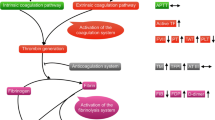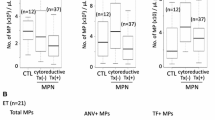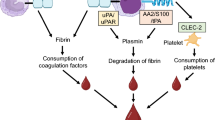Abstract
The frequent serious bleeding and thrombotic complications in acute promyelocytic leukemia (APL) are major causes of early mortality, but the complex mechanisms causing the bleeding have not been completely elucidated. Because microparticles (MPs) are known to be elevated in thromboembolic disorders, we hypothesized a role for MPs in the pathogenesis of coagulopathy in APL. MPs were isolated from 30 APL patients and 20 healthy subjects and from cultured NB4/APL cells. The morphology of the MPs was examined, and they were quantified and analyzed for their thrombin-generating potential. We confirmed the existence of promyelocytic-derived MPs by morphology using transmission electron microscopy and laser scanning confocal microscopy. Counts of MPs in APL were elevated and were typically from promyelocytic cells (CD33+ TF+ MPs). Importantly, the CD33+ MPs strongly correlated with patient leukocyte count (R = 0.64, p = 0.002) and D-dimer (R = 0.51, p = 0.0038). Moreover, the MPs from patients with APL decreased the coagulation times and induced thrombin generation. APL MP-associated thrombin generation was reduced by 54 % when the extrinsic pathway was blocked using an anti-human tissue factor (TF) antibody. However, neither anti-factor XI nor anti-tissue factor pathway inhibitor had any significant inhibitory effect. Our results show that the procoagulant state in APL is partially due to the TF-dependent procoagulant properties of circulating promyelocytic-derived MPs. TF+ MPs may be a novel potential risk factor for coagulopathy in APL.





Similar content being viewed by others
Abbreviations
- APL:
-
Acute promyelocytic leukemia
- MPs:
-
Microparticles
- DIC:
-
Disseminated intravascular coagulation
- TF:
-
Tissue factor
- TEM:
-
Transmission electron microscope
- LSCM:
-
Laser scanning confocal microscopy
- PS:
-
Phosphatidylserine
References
Tallman MS, Abutalib SA, Altman JK (2007) The double hazard of thrombophilia and bleeding in acute promyelocytic leukemia. Semin Thromb Hemost 33:330–338. doi:10.1055/s-2007-976168
Stein E, McMahon B, Kwaan H, Altman JK, Frankfurt O, Tallman MS (2009) The coagulopathy of acute promyelocytic leukaemia revisited. Best Pract Res Clin Haematol 22:153–163. doi:10.1016/j.beha.2008.12.007
Sanz MA, Montesinos P (2010) Open issues on bleeding and thrombosis in acute promyelocytic leukemia. Thromb Res 125(Suppl 2):S51–S54. doi:10.1016/S0049-3848(10)70013-X
Tallmann MS (2004) Curative therapeutic approaches to APL. Ann Hematol 83(Suppl 1):S81–S82. doi:10.1007/s00277-004-0850-2
Jacomo RH, Melo RA, Souto FR, de Mattos ER, de Oliveira CT, Fagundes EM, Bittencourt HN, Bittencourt RI, Bortolheiro TC, Paton EJ, Bendlin R, Ismael S, Chauffaille Mde L, Silva D, Pagnano KB, Ribeiro R, Rego EM (2007) Clinical features and outcomes of 134 Brazilians with acute promyelocytic leukemia who received ATRA and anthracyclines. Haematologica 92:1431–1432. doi:10.3324/haematol.10874
Menell JS, Cesarman GM, Jacovina AT, McLaughlin MA, Lev EA, Hajjar KA (1999) Annexin II and bleeding in acute promyelocytic leukemia. N Engl J Med 340:994–1004. doi:10.1056/NEJM199904013401303
Kwaan HC (2007) Double hazard of thrombophilia and bleeding in leukemia. Hematol Am Soc Hematol Educ Program 151–157. doi:10.1182/asheducation-2007.1.151
van EJ B, Schaap MC, Berckmans RJ, Nieuwland R, Sturk A, van Doormaal FF, Meijers JC, Biemond BJ, Curama study group (2009) Circulating erythrocyte-derived microparticles are associated with coagulation activation in sickle cell disease. Haematologica 94:1513–1519. doi:10.3324/haematol.2009.008938
Puddu P, Puddu GM, Cravero E, Muscari S, Muscari A (2010) The involvement of circulating microparticles in inflammation, coagulation and cardiovascular diseases. Can J Cardiol 26:140–145
Burnier L, Fontana P, Kwak BR, Angelillo-Scherrer A (2009) Cell-derived microparticles in haemostasis and vascular medicine. Thromb Haemost 101:439–451
Owens AP 3rd, Mackman N (2011) Microparticles in hemostasis and thrombosis. Circ Res 108:1284–1297. doi:10.1161/CIRCRESAHA.110.233056
Nomura S, Ozaki Y, Ikeda Y (2008) Function and role of microparticles in various clinical settings. Thromb Res 123:8–23
Kwaan HC, Rego EM (2010) Role of microparticles in the hemostatic dysfunction in acute promyelocytic leukemia. Semin Thromb Hemost 36:917–924
Antonelou MH, Papassideri IS, Karababa FJ, Loutradi A, Margaritis LH (2003) Ultrastructural characterization of the erythroid cells in a novel case of congenital anemia. Blood Cells Mol Dis 30:30–42
Berckmans RJ, Nieuwland R, Boing AN, Romijn FP, Hack CE, Sturk A (2001) Cell-derived microparticles circulate in healthy humans and support low grade thrombin generation. Thromb Haemost 85:639–646
Lacroix R, Dignat-George F (2012) Microparticles as a circulating source of procoagulant and fibrinolytic activities in the circulation. Thromb Res 129 Suppl 2:27–29
Katzenell S, Shomer E, Zipori Y, Zylberfisz A, Brenner B, Aharon A (2012) Characterization of negatively charged phospholipids and cell origin of microparticles in women with gestational vascular complications. Thromb Res 130:479–484
Morel O, Toti F, Hugel B, Bakouboula B, Camoin-Jau L, Dignat-George F, Freyssinet JM (2006) Procoagulant microparticles: disrupting the vascular homeostasis equation? Arterioscler Thromb Vasc Biol 26:2594–2604
Morel O, Jesel L, Freyssinet JM, Toti F (2011) Cellular mechanisms underlying the formation of circulating microparticles. Arterioscler Thromb Vasc Biol 31:15–26
Chang H, Kuo MC, Shih LY, Dunn P, Wang PN, Wu JH, Lin TL, Hung YS, Tang TC (2012) Clinical bleeding events and laboratory coagulation profiles in acute promyelocytic leukemia. Eur J Haematol 88:321–328
Fang Y, Cai JY, Zhong JH, Zhong H, Wang HR, Chen FY (2011) Expression of alternatively spliced human tissue factor in acute leukemia cells. Zhongguo Shi Yan Xue Ye Xue Za Zhi 19:288–292
Langer F, Spath B, Haubold K, Holstein K, Marx G, Wierecky J, Brümmendorf TH, Dierlamm J, Bokemeyer C, Eifrig B (2008) Tissue factor procoagulant activity of plasma microparticles in patients with cancer-associated disseminated intravascular coagulation. Ann Hematol 87:451–457
Kravtsov DV, Matafonov A, Tucker EI, Sun MF, Walsh PN, Gruber A, Gailani D (2009) Factor XI contributes to thrombin generation in the absence of factor XII. Blood 114:452–458
Falanga A, Consonni R, Marchetti M, Mielicki WP, Rambaldi A, Lanotte M, Gordon SG, Barbui T (1994) Cancer procoagulant in the human promyelocytic cell line NB4 and its modulation by all-trans-retinoic acid. Leukemia 8:156–159
De Stefano V, Teofili L, Sica S, Mastrangelo S, Di Mario A, Rutella S, Salutari P, Rumi C, d’Onofrio G, Leone G (1995) Effect of all-trans retinoic acid on procoagulant and fibrinolytic activities of cultured blast cells from patients with acute promyelocytic leukemia. Blood 86:3535–3541
Falanga A, Consonni R, Marchetti M, Locatelli G, Garattini E, Passerini CG, Gordon SG, Barbui T (1998) Cancer procoagulant and tissue factor are differently modulated by all-trans-retinoic acid in acute promyelocytic leukemia cells. Blood 92:143–151
Pan JJ, Shi HM, Luo XP, Ma D, Li Y, Zhu J, Liang W, Mu JG, Li J (2011) Recombinant TFPI-2 enhances macrophage apoptosis through upregulation of Fas/FasL. Eur J Pharmacol 654:135–141
Walsh PN (2001) Roles of platelets and factor XI in the initiation of blood coagulation by thrombin. Thromb Haemost 86:75–82
Cosmi B, Legnani C, Tosetto A, Pengo V, Ghirarduzzi A, Alatri A, Prisco D, Poli D, Tripodi A, Palareti G (2009) Use of D-dimer testing to determine duration of anticoagulation, risk of cardiovascular events and occult cancer after a first episode of idiopathic venous thromboembolism: the extended follow-up of the PROLONG study. J Thromb Thrombolysis 28:381–388
Reitsma PH, Versteeg HH, Middeldorp S (2012) Mechanistic view of risk factors for venous thromboembolism. Arterioscler Thromb Vasc Biol 32:563–568
Flores-Nascimento MC, Beltrame MP, De Paula EV, Montalvao SL, Pereira FG, Orsi FL, Lorand-Metze I, Annichino-Bizzacchi JM (2009) Microparticles in deep venous thrombosis, antiphospholipid syndrome and factor V Leiden. Platelets 20:367–375
Ye R, Ye C, Huang Y, Liu L, Wang S (2011) Circulating tissue factor positive microparticles in patients with acute recurrent deep venous thrombosis. Thromb Res 130:253–258
Acknowledgments
This research was supported by the Natural Scientific Foundation of Heilongjiang Province (D200861, China), the Supporting Certification of Postdoctoral Heilongjiang Science Research Foundation (LBH-Q10029, China), and the Research Fund for the Doctoral Program of Higher Education (20112307110012, China). We thank Linfeng Cao, Xiuhua Liu, Yueqiu Teng, Zhiyu Liu, and Zhenkun Wang for excellent technical assistance.
Conflict of interest
The authors declare that they have no conflict of interest.
Author information
Authors and Affiliations
Corresponding author
Rights and permissions
About this article
Cite this article
Ma, G., Liu, F., Lv, L. et al. Increased promyelocytic-derived microparticles: a novel potential factor for coagulopathy in acute promyelocytic leukemia. Ann Hematol 92, 645–652 (2013). https://doi.org/10.1007/s00277-013-1676-6
Received:
Accepted:
Published:
Issue Date:
DOI: https://doi.org/10.1007/s00277-013-1676-6




